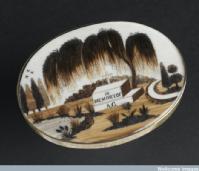Seminar 19: Dignity in Dying (Media Watch: Attitudes to Dying)
 |
The final seminar explores attitudes to dying in modern Britain, surveying responses along lines of class and gender and attitudes towards bereavement in poor and pauper families. It also explores the care of the dying, and the origins of the hospice movement, as well as particular responses to the deaths of infants. Though a media watch, we will connect discussion of the historical past to current debates on the care of the terminally ill and on euthanasia to see in what ways, if at all, they appear to draw on historical research on the process of dying, grieving and mourning. |
1. What was regarded as a ‘good death’ in Victorian Britain?
2. How have attitudes towards death changed in the twentieth century?
Seminar Reading:
Julie-Marie Strange, ‘She Cried a Very Little: Death, Grief and Mourning in Working-Class Culture, c.1880-1914’, Social History, 27 (2002), 143-61. e-journal
Claire Humphreys, ‘“Waiting for the Last Summons”: The Establishment of the First Hospices in England 1878-1914’, Mortality, 6 (2001), 146-66. e-journal
David Clark, ‘Originating a Movement: Cicely Saunders and the Development of St. Christopher’s Hospice, 1957-67’, Mortality, 3 (2000), 43-63. e-journal
Primary Sources
Pat Jalland and John Hooper (eds), Women From Birth to Death: The Female Life Cycle in Britain 1830-1914 (Brighton: Harvester, 1986), 'From Menopause to Death'. Click here
Additional Reading:
David Clark, ‘Hospice in Historical Pespective’, in Glennys Howarth and Oliver Leaman (eds), Encyclopaedia of Death and Dying (London: Routledge, 2001).
H.L. Gynn Hughes, Peace at Last: A Survey of Terminal Care in the United Kingdom (London: UK and British Commonwealth Press, 1960).
Anne Hardy, ‘“Death is the Cure of All Diseases”: Using the General Register Office Cause of Death Statistics for 1837–1920’, Social History of Medicine, 7 (1994) 472-92. e-journal
Glennys Howarth, Last Rites: The Work of the Modern Funeral Director (New York: Baywood, 1996).
Elizabeth Hurren, Dying for Victorian Medicine: English Anatomy and its Trade in the Dead Poor, c.1834-1929 (Basingstoke: Palgrave Macmillan, 2011). e-book
Pat Jalland, Death in the Victorian Family (Oxford: Oxford University Press, 1996).
Peter Jupp and Clare Gittings (eds), Death in England: An Illustrated History (Manchester: Manchester University Press, 1999).
Allan Kellehear, A Social History of Dying (Cambridge: Cambridge University Press, 2007).
James Milton, Medicine and the Care of the Dying (Oxford: Oxford University Press, 2007).
Roy Porter, Bodies Politic: Disease, Death and Doctors, 1650-1900 (London: Reaktion, 2001).
Ruth Richardson, Death, Dissection and the Destitute (London: Pheonix, 1987).
E. Ross, Love and Toil: Motherhood in Outcast London, 1870-1918 (New York: Oxford University Press, 1993), ch. 6, ‘Caring for Sick and Dying Children’.
Julie-Marie Strange, Death, Grief and Poverty in Britain, 1870-1914 (Cambridge: Cambridge University Press, 2005), esp. ch 2.
Julie-Marie Strange, ‘Historical Approaches to Dying’, in Allan Kellehear (ed.), The Study of Dying: From Autonomy to Transformation (New York and Cambridge: Cambridge University Press, 2010), 123-46.
Julie-Marie Strange, ‘“Speechless with Grief”: Bereavement and the Working-Class Father, c. 1880-1914’, in T.L. Broughton and H. Rogers (eds), Gender and Fatherhood in the Nineteenth Century (Houndmills: Palgrave Macmillan, 2007), 138-49.
Julie-Marie Strange, ‘Only a Pauper whom Nobody Owns: Reassessing the Pauper Grave, c.1880-1914’, Past and Present, 178 (2003), 148-75. e-journal
Essay Question
What was regarded a 'good death' in modern Britain?
How did attitudes and behaviours towards death vary according to class and gender?
In what ways was death medicalised in modern Britain?
